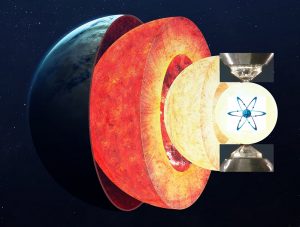
New work from a research team led by Carnegie’s Anat Shahar contains some unexpected findings about iron chemistry under high-pressure conditions, such as those likely found in the Earth’s core, where iron predominates and creates our planet’s life-shielding magnetic field. Their results, published in Science, could shed light on Earth’s early days when the core was formed through a process called differentiation—when the denser materials, like iron, sunk inward toward the center, creating the layered composition the planet has today.
Earth formed from accreted matter surrounding the young Sun. Over time, the iron in this early planetary material moved inward, separating from the surrounding silicate. This process created the planet’s iron core and silicate upper mantle. But much about this how this differentiation process occurred is still poorly understood, due to the technological impossibility of taking samples from the Earth’s core to see which compounds exist there.
Seismic data show that in addition to iron, there are “lighter” elements present in the core, but which elements and in what concentrations they exist has been a matter of great debate. This is because as the iron moved inward toward the core, it interacted with various lighter elements to form different alloyed compounds, which were then carried along with the iron into the planet’s depths.
Which elements iron bonded with during this time would have been determined by the surrounding conditions, including pressure and temperature. As a result, working backward and determining which iron alloy compounds were created during differentiation could tell scientists about the conditions on early Earth and about the planet’s geochemical evolution.
The team—including Carnegie’s Jinfu Shu and Yuming Xiao—decided to investigate this subject by researching how pressures mimicking the Earth’s core would affect the composition of iron isotopes in various alloys of iron and light elements. Isotopes are versions of an element where the number of neutrons differs from the number of protons. (Each element contains a unique number of protons.)
Because of this accounting difference, isotopes’ masses are not the same, which can sometimes cause small variations in how different isotopes of the same element are partitioned in, or are “picked up” by, either silicate or iron metal. Some isotopes are preferred by certain reactions, which results in an imbalance in the proportion of each isotope incorporated into the end products of these reactions—a process that can leave behind trace isotopic signatures in rocks. This phenomenon is called isotope fractionation and is crucial to the team’s research.
Before now, pressure was not considered a critical variable affecting isotope fractionation. But Shahar and her team’s research demonstrated that for iron, extreme pressure conditions do affect isotope fractionation.
More importantly, the team discovered that due to this high-pressure fractionation, reactions between iron and two of the light elements often considered likely to be present in the core—hydrogen and carbon—would have left behind an isotopic signature in the mantle silicate as they reacted with iron and sunk to the core. But this isotopic signature has not been found in samples of mantle rock, so scientists can exclude them from the list of potential light elements in the core.
Oxygen, on the other hand, would not have left an isotopic signature behind in the mantle, so it is still on the table. Likewise, other potential core light elements still need to be investigated, including silicon and sulfur.
“What does this mean? It means we are gaining a better understanding of our planet’s chemical and physical history,” Shahar explained. “Although Earth is our home, there is still so much about its interior that we don’t understand. But evidence that extreme pressures affect how isotopes partition, in ways that we can see traces of in rock samples, is a huge step forward in learning about our planet’s geochemical evolution.”
Reference:
“Pressure-dependent isotopic composition of iron alloys” Science, DOI: 10.1126/science.aad9945
Note: The above post is reprinted from materials provided by Carnegie Institution for Science.










